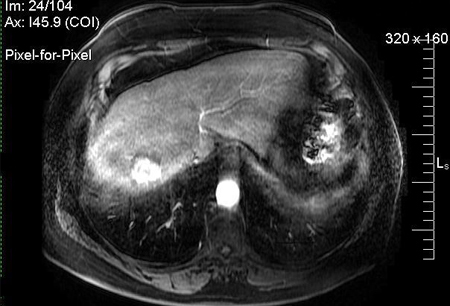Resumo
Definição
História e exame físico
Principais fatores diagnósticos
- history of cirrhosis
- history of chronic hepatitis B (HBV) or C (HCV)
- history of chronic heavy alcohol use
- history of diabetes or obesity
- family history of liver cancer
- older age
- hepatomegaly
Outros fatores diagnósticos
- abdominal distension
- esophageal or gastric variceal bleeding
- right upper quadrant abdominal pain
- early satiety
- weight loss
- lower extremity edema
- hepatic encephalopathy
- cachexia
- jaundice
- splenomegaly
- asterixis
- spider nevi
- palmar erythema
- periumbilical collateral veins
- fetor hepaticus
- diarrhea
- paraneoplastic syndrome
- bone pain
- severe abdominal pain
- obstructive jaundice
- enlarged hemorrhoidal veins
- vascular bruit
Fatores de risco
- cirrhosis
- chronic hepatitis B (HBV) infection
- chronic hepatitis C (HCV) infection
- chronic heavy alcohol use
- diabetes
- obesity
- family history of liver cancer
- aflatoxin exposure
- thorium dioxide radioactive contrast exposure
- hemochromatosis
- cigarette smoking
- alpha-1-antitrypsin deficiency
- porphyria cutanea tarda
- primary biliary cholangitis (PBC)
- primary sclerosing cholangitis (PSC)
- use of androgenic steroids
- use of oral contraceptives
- male sex
Investigações diagnósticas
Primeiras investigações a serem solicitadas
- complete blood count
- basic metabolic panel
- liver function tests
- prothrombin time/INR
- viral hepatitis panel
- alpha fetoprotein (AFP)
- ultrasound of liver
Investigações a serem consideradas
- contrast CT scan of abdomen
- contrast MRI of abdomen
- liver biopsy
- computed tomography scan of chest
- bone scan
Algoritmo de tratamento
Barcelona Clinic Liver Cancer (BCLC) stage 0-A (very early 0 or early disease A): possible surgical candidate (good liver function)
BCLC stage 0-A (very early 0 or early disease A): nonhepatic resection candidate
BCLC stage B: intermediate disease
BCLC stage C: advanced disease
BCLC stage D: end-stage disease
recurrence
Colaboradores
Autores
Doan Y Dao, MD
Assistant Professor of Medicine
Director, Center of Excellence for Liver Disease in Vietnam
Johns Hopkins School of Medicine
Department of Medicine
Division of GI & Hepatology
Baltimore
MD
Declarações
DYD receives grants from Roche, Fujifilm Medical System, and DELFI Diagnostics; serves as Guest Director of Hepatology for Tech University; and is a member of the Data and Safety Monitoring Board of IQVIA.
Ngoc-Thai Truong, MD, MS
Research Assistant
Vietnam Viral Hepatitis Alliance
Reston
VA
Declarações
NTT declares that he has no competing interests.
Agradecimentos
Dr Doan Y Dao and Dr Ngoc-Thai Truong would like to gratefully acknowledge Dr Qingyao Daniel Huang, Dr Margaret Li Peng Teng, Dr Poh Seng Tan, Dr Badar Muneer, and Dr Smruti R. Mohanty, previous contributors to this topic.
Declarações
QDH declares that he has no competing interests. MLPT declares that she has no competing interests. PST has received sponsorship/honorarium from Bayer (South East Asia) Pte Ltd and Sirtex for attending conferences, delivering lectures, and participating in advisory board meetings. BM declares that he has no competing interests. SRM serves as a speaker for Bristol-Myers Squibb regarding the use of entecavir for the treatment of chronic hepatitis B.
Revisores
Srikrishna Nagri, MD
Gastroenterologist
Dartmouth-Hitchcock Nashua
Nashua
NH
Declarações
SN declares that he has no competing interests.
Ned Snyder, MD, FACP
Professor of Medicine
Chief of Clinical Gastroenterology and Hepatology
University of Texas Medical Branch
Galveston
TX
Declarações
NS declares that he has no competing interests.
Créditos aos pareceristas
Os tópicos do BMJ Best Practice são constantemente atualizados, seguindo os desenvolvimentos das evidências e das diretrizes. Os pareceristas aqui listados revisaram o conteúdo pelo menos uma vez durante a história do tópico.
Declarações
As afiliações e declarações dos pareceristas referem--se ao momento da revisão.
Referências
Principais artigos
Singal AG, Llovet JM, Yarchoan M, et al. AASLD practice guidance on prevention, diagnosis, and treatment of hepatocellular carcinoma. Hepatology. 2023 Dec 1;78(6):1922-65.Texto completo Resumo
Vogel A, Cervantes A, Chau I, et al. Hepatocellular carcinoma: ESMO clinical practice guidelines for diagnosis, treatment and follow-up. Ann Oncol. 2018 Oct 1;29 (suppl 4):iv238-55.Texto completo Resumo
European Association for the Study of the Liver. EASL clinical practice guidelines: management of hepatocellular carcinoma. J Hepatol. 2018 Jul;69(1):182-236.Texto completo Resumo
Su GL, Altayar O, O'Shea R, et al. AGA clinical practice guideline on systemic therapy for hepatocellular carcinoma. Gastroenterology. 2022 Mar;162(3):920-34.Texto completo Resumo
Gordan JD, Kennedy EB, Abou-Alfa GK, et al. Systemic therapy for advanced hepatocellular carcinoma: ASCO guideline update. J Clin Oncol. 2024 May 20;42(15):1830-50.Texto completo Resumo
Artigos de referência
Uma lista completa das fontes referenciadas neste tópico está disponível para os usuários com acesso total ao BMJ Best Practice.

Diagnósticos diferenciais
- Cholangiocarcinoma
- Hepatic adenoma
- Hemangioma of liver
Mais Diagnósticos diferenciaisDiretrizes
- NCCN clinical practice guidelines in oncology: management of immunotherapy-related toxicities
- Systemic therapy for advanced hepatocellular carcinoma
Mais DiretrizesCalculadoras
Child Pugh classification for severity of liver disease
MELD Score for End-Stage Liver Disease (NOT appropriate for patients under the age of 12)
Mais CalculadorasConectar-se ou assinar para acessar todo o BMJ Best Practice
O uso deste conteúdo está sujeito ao nosso aviso legal